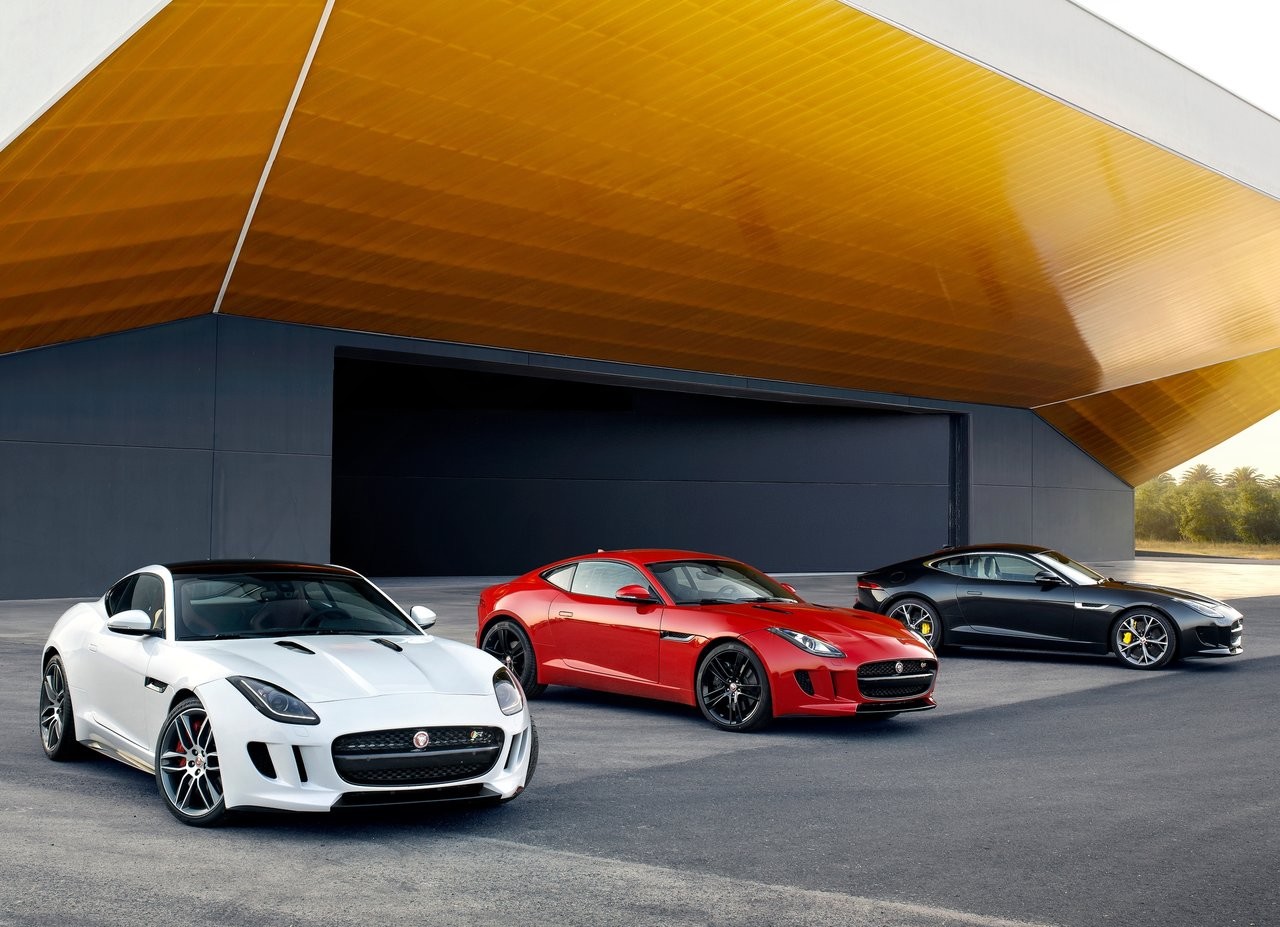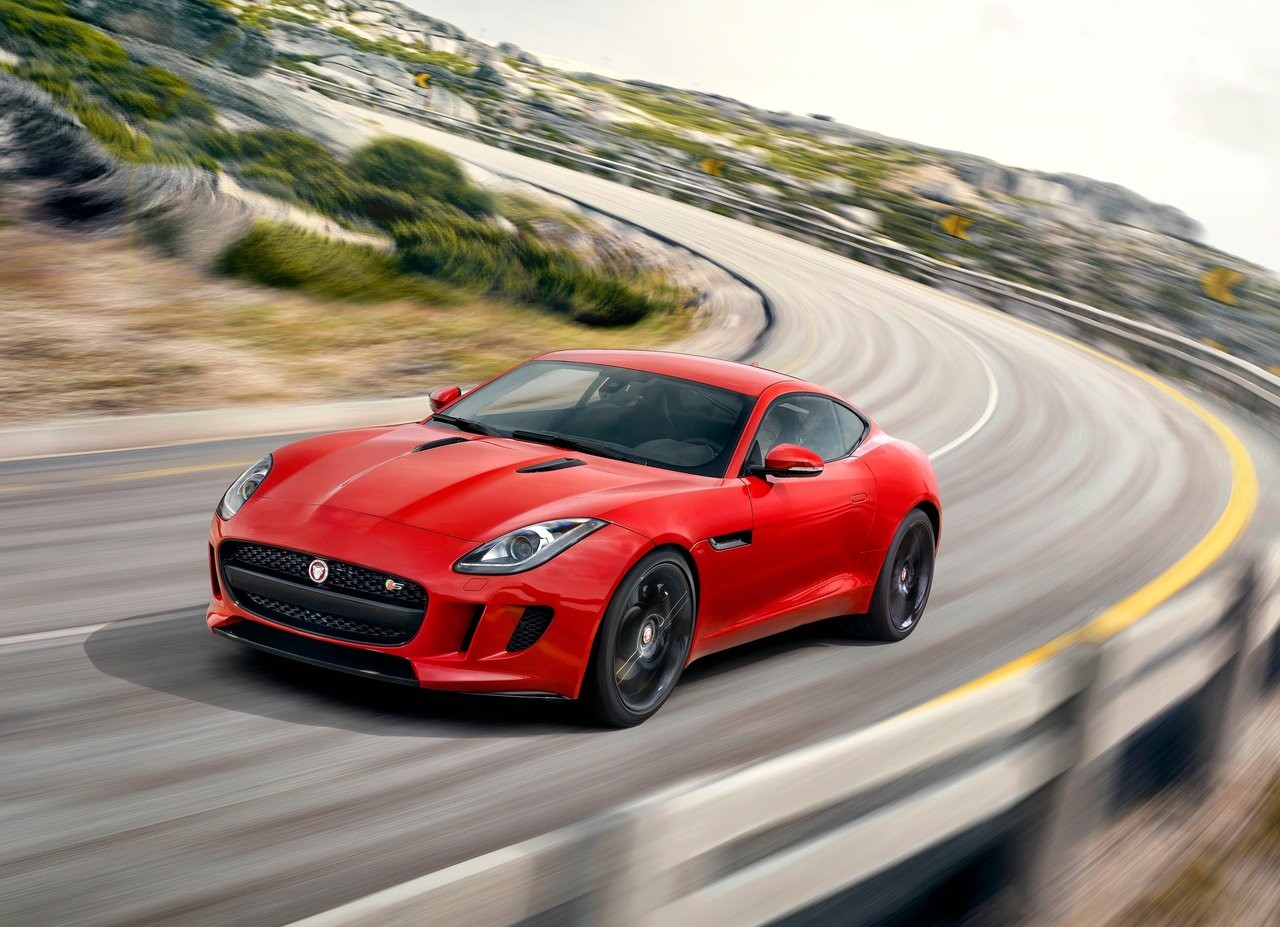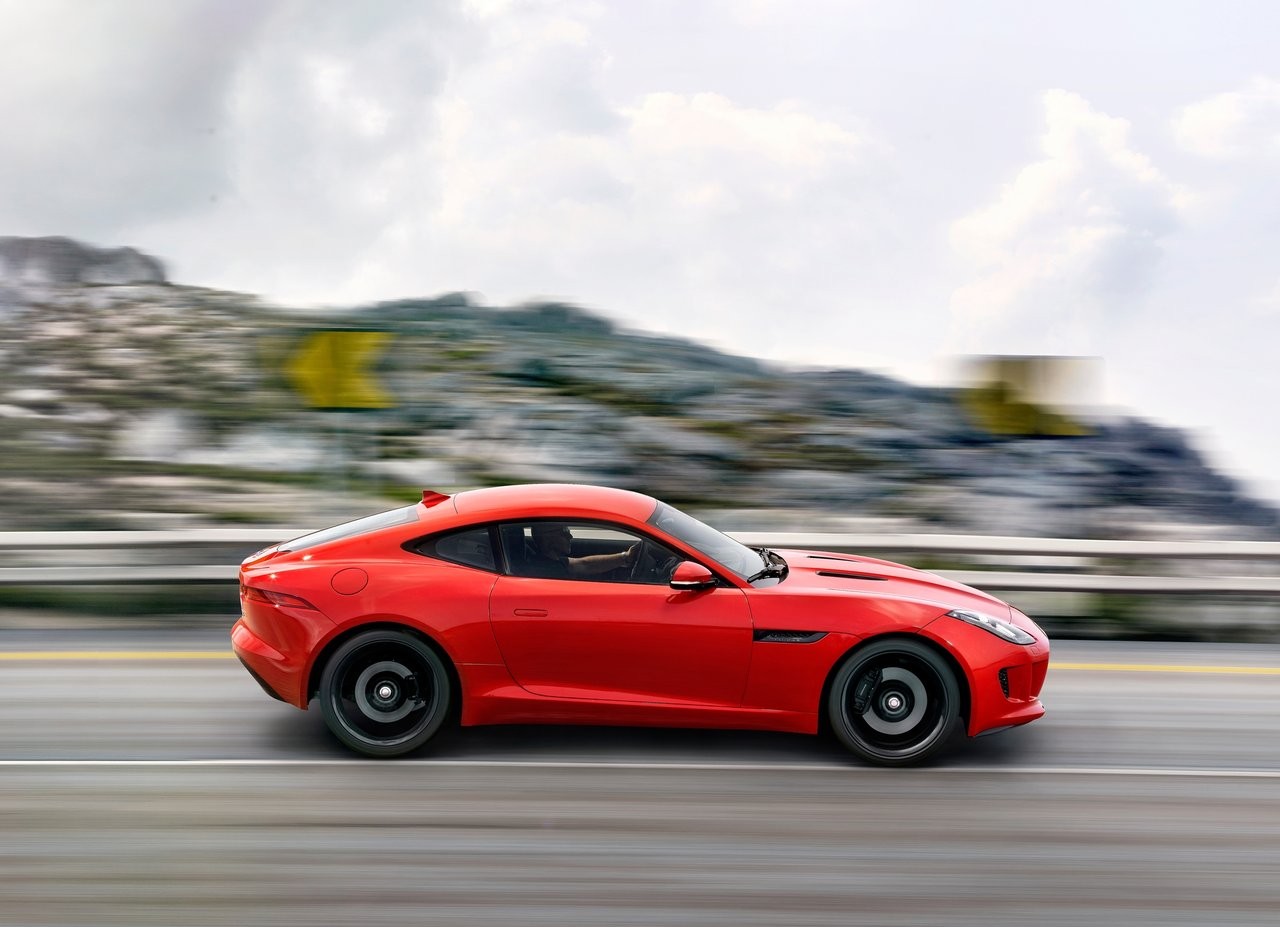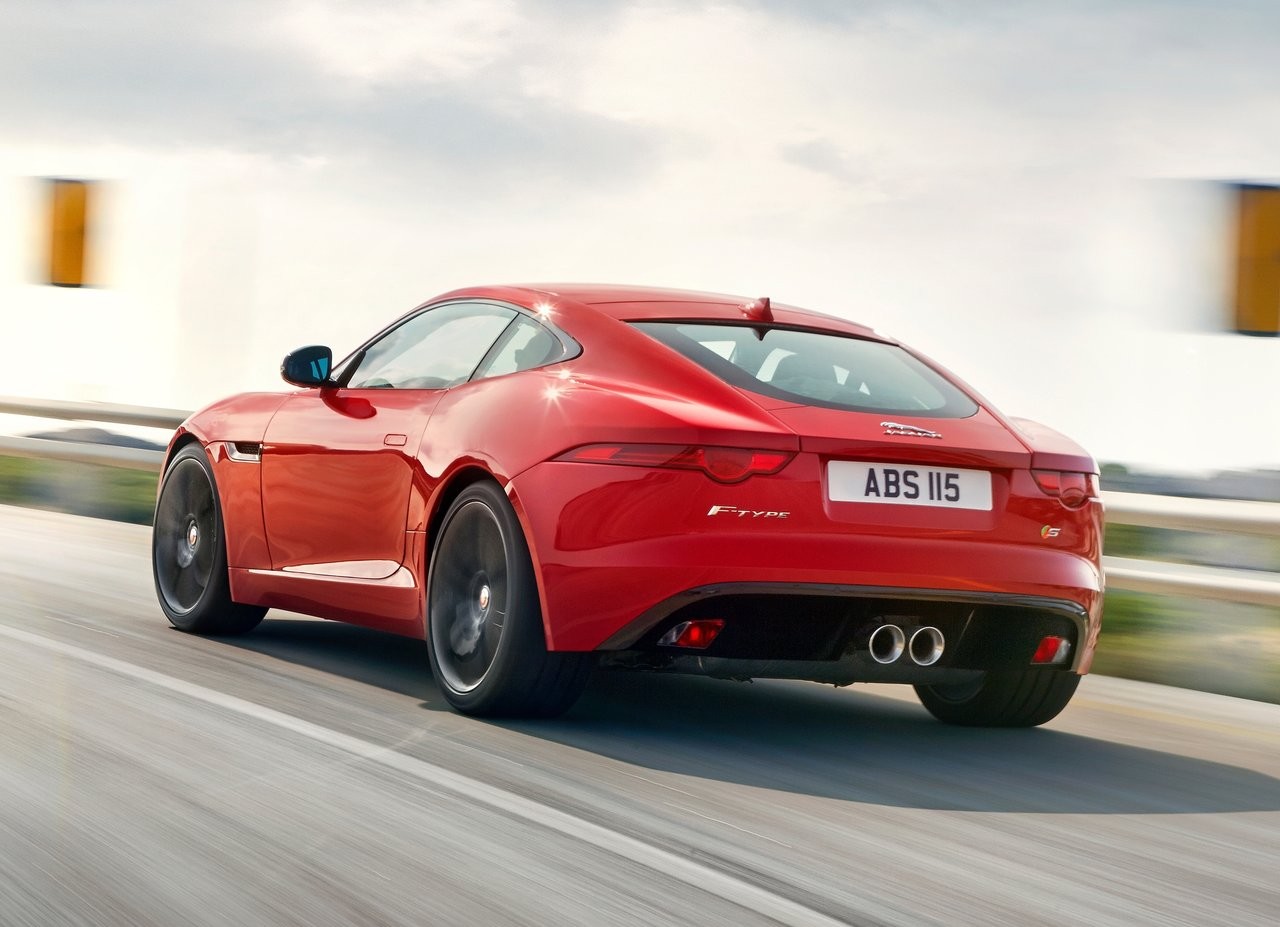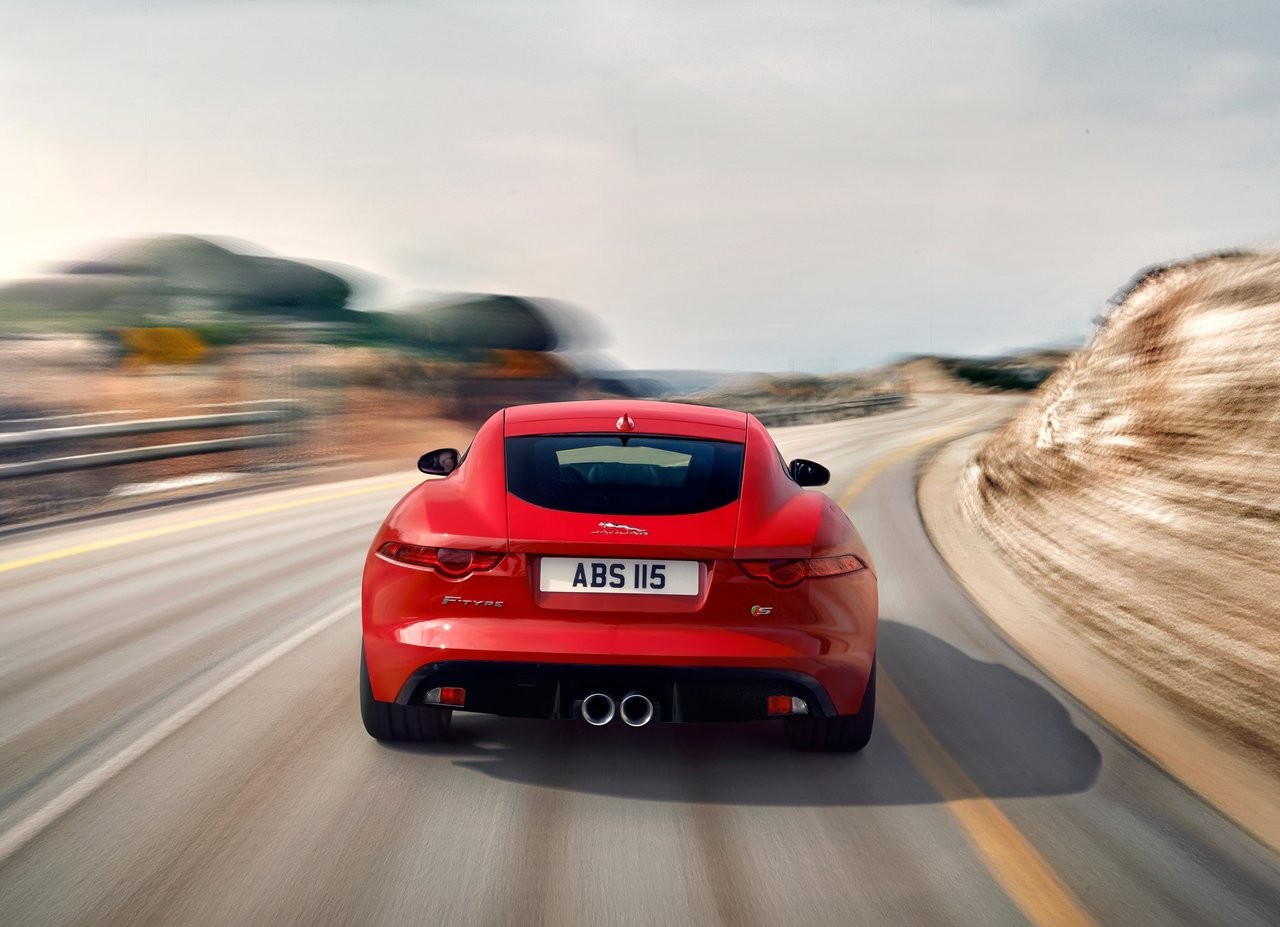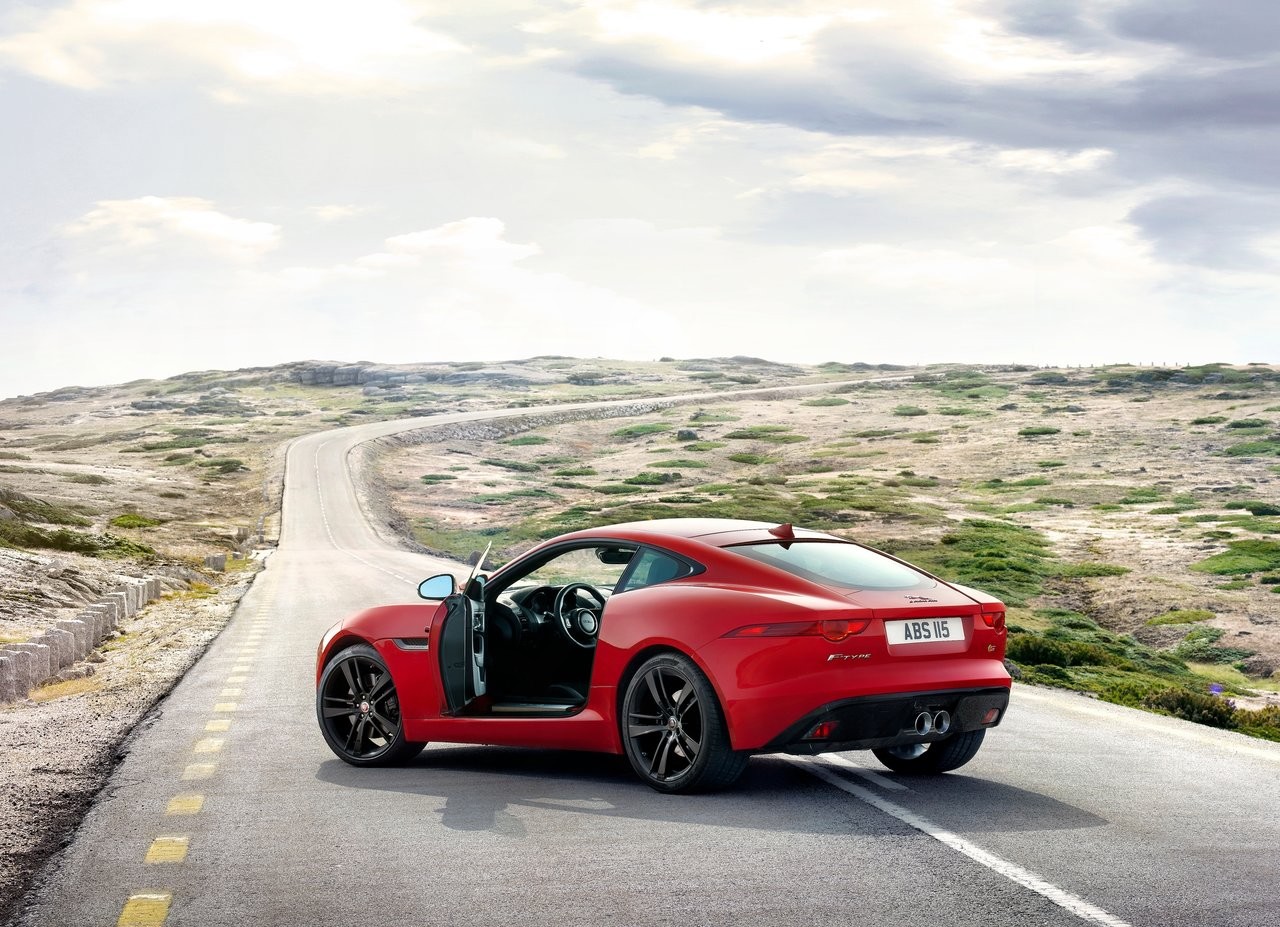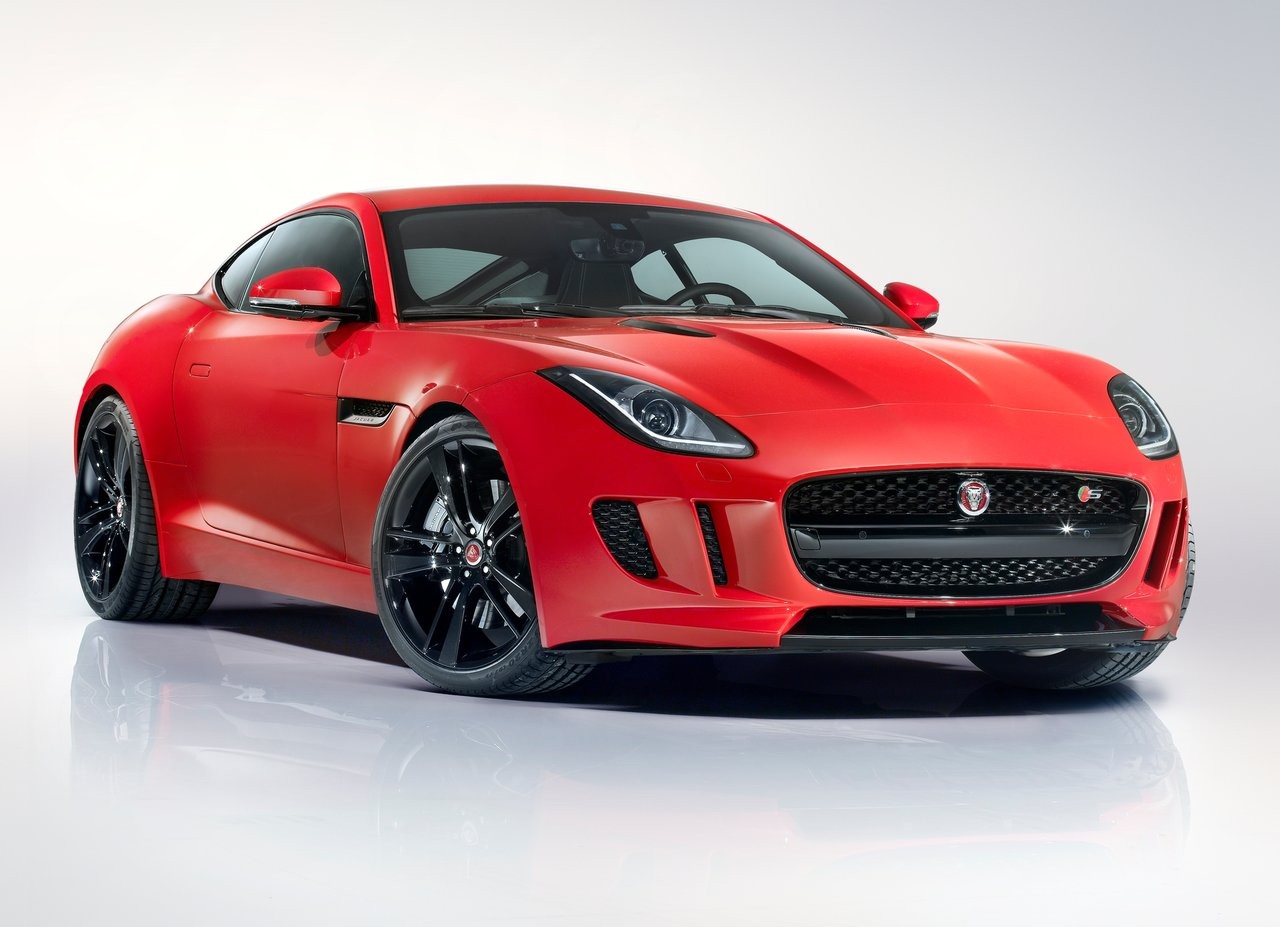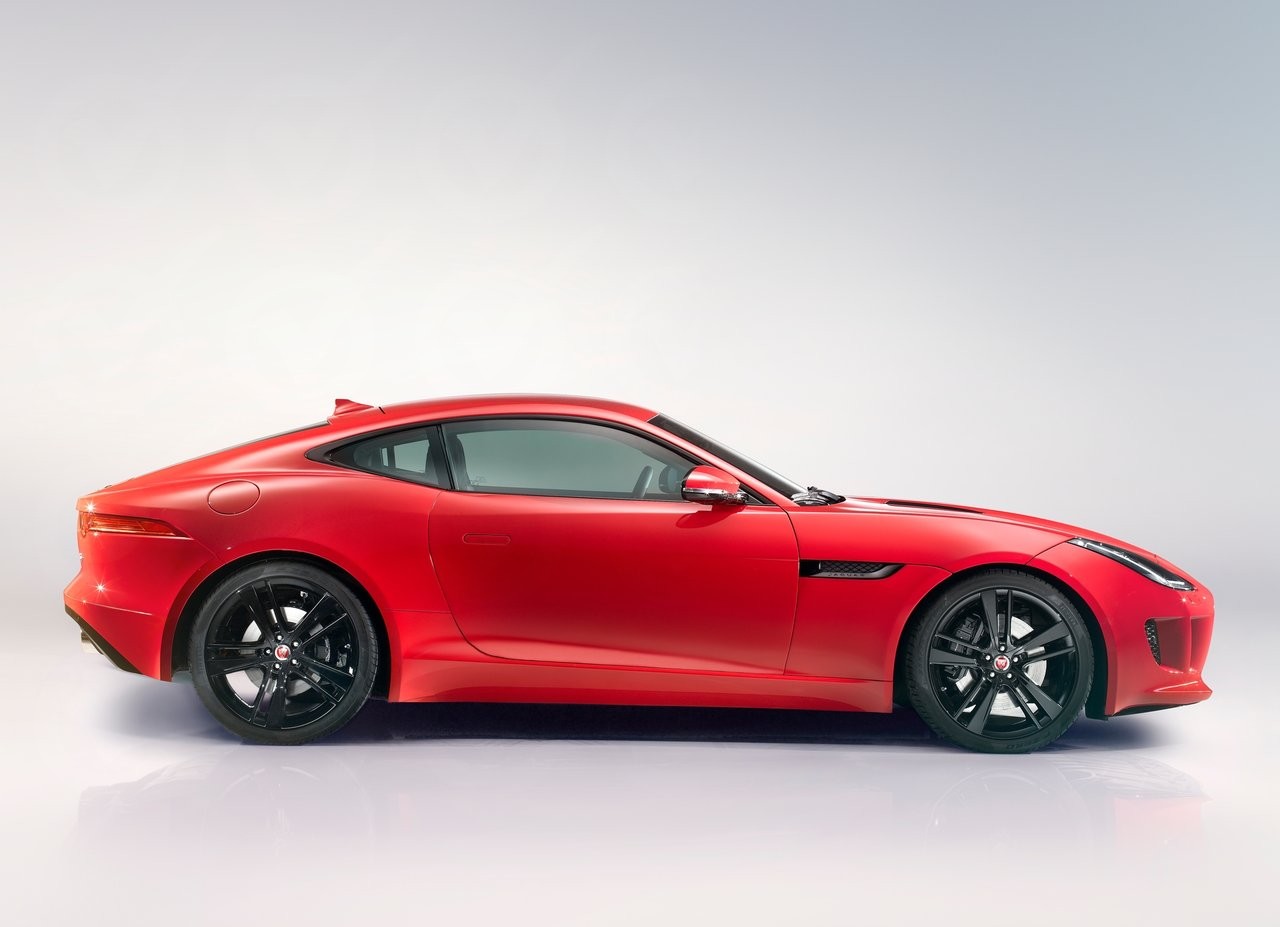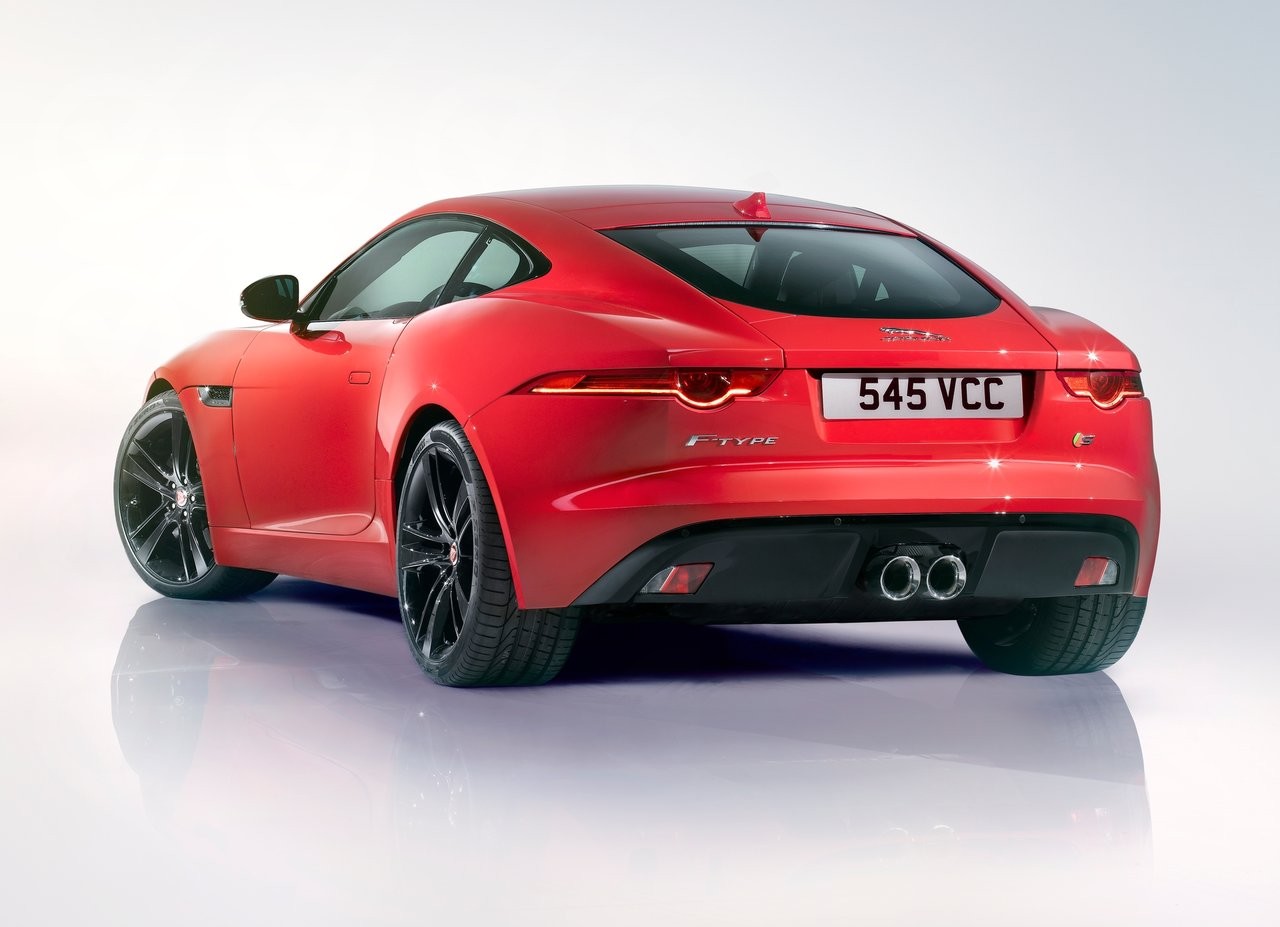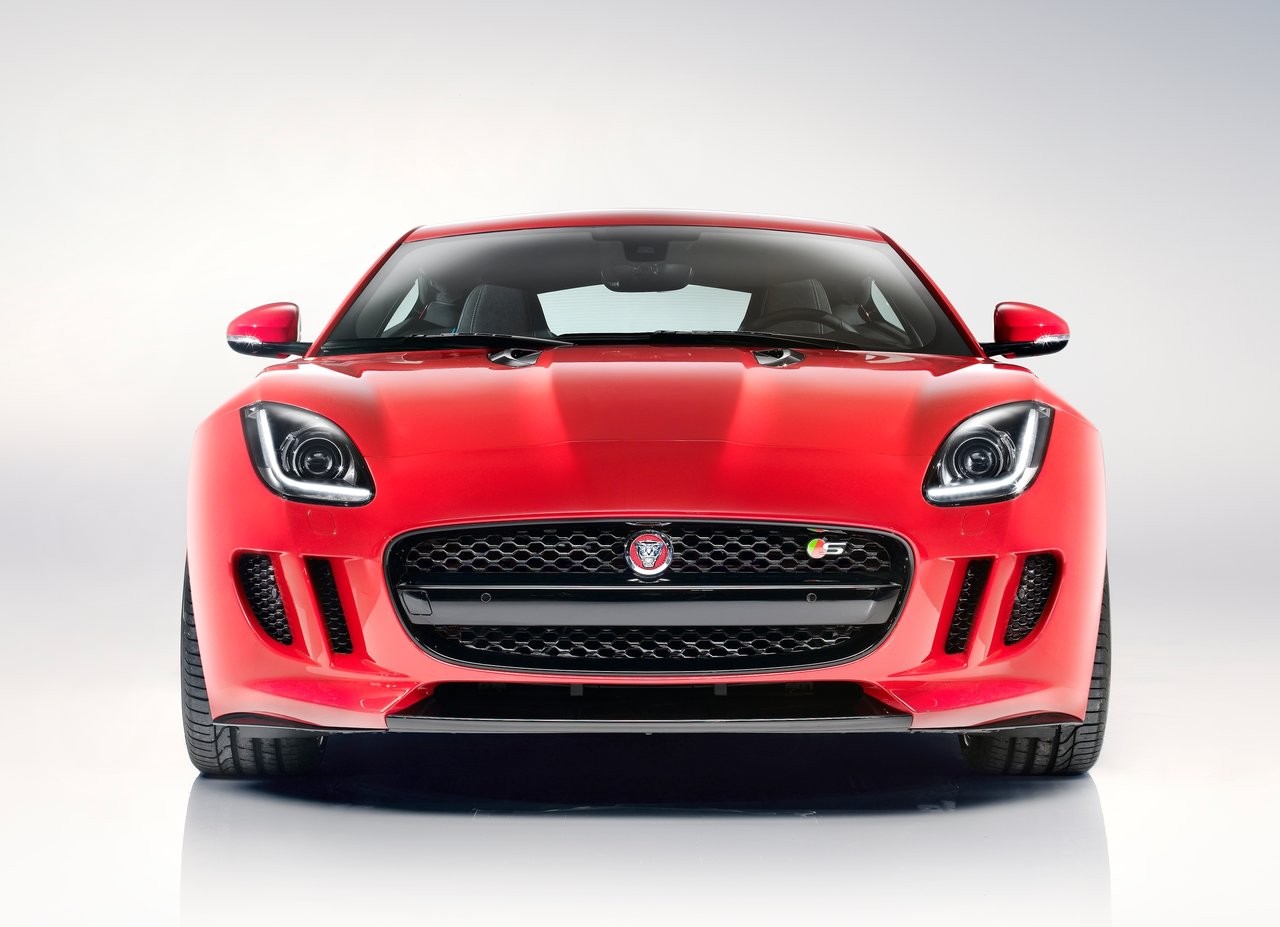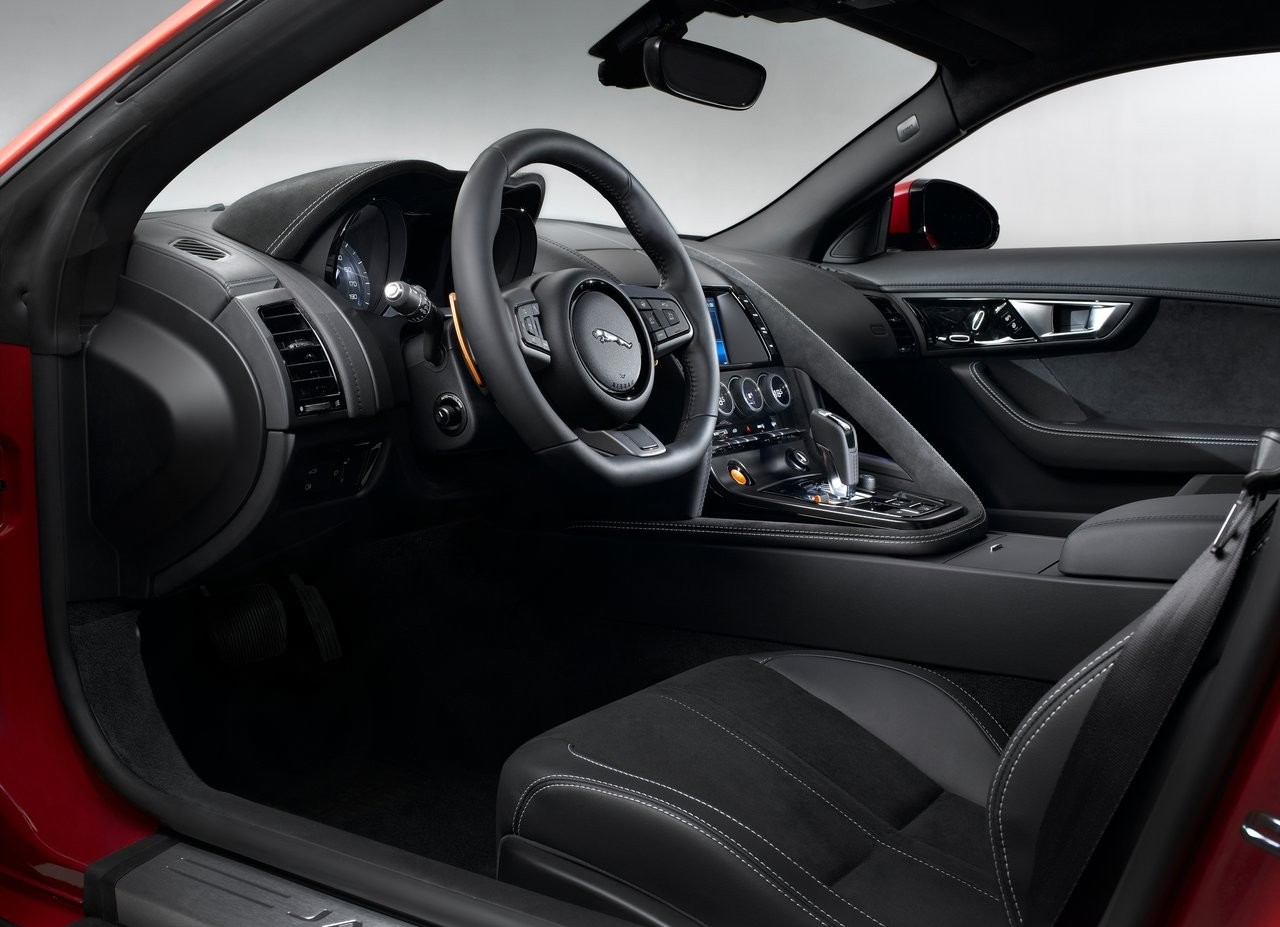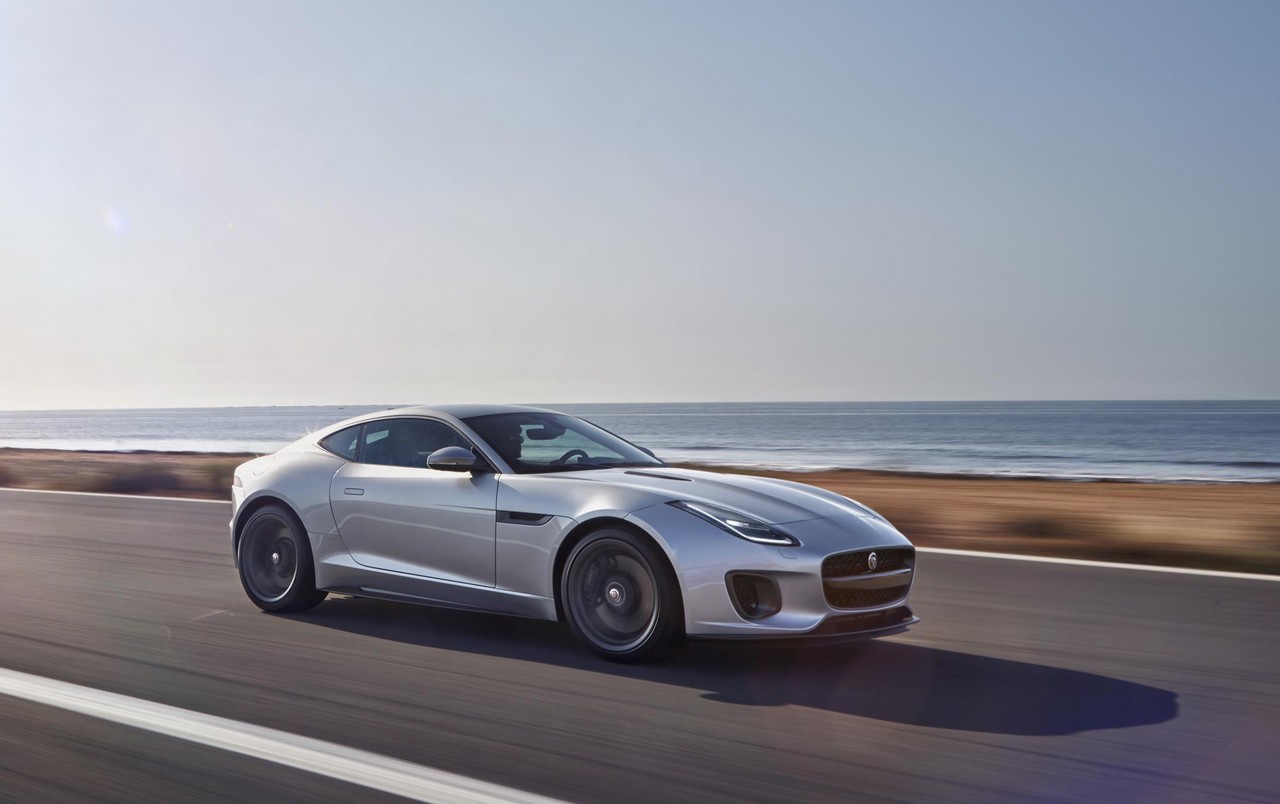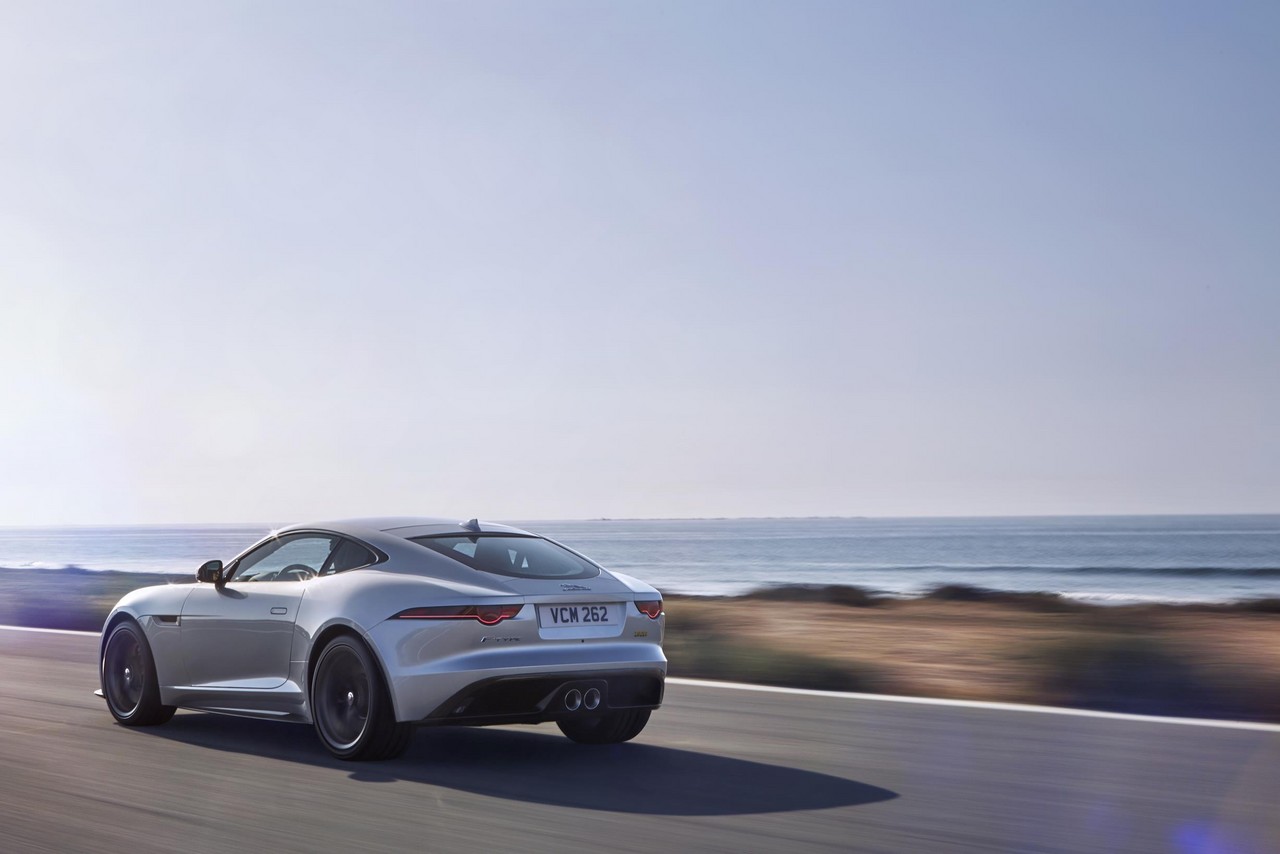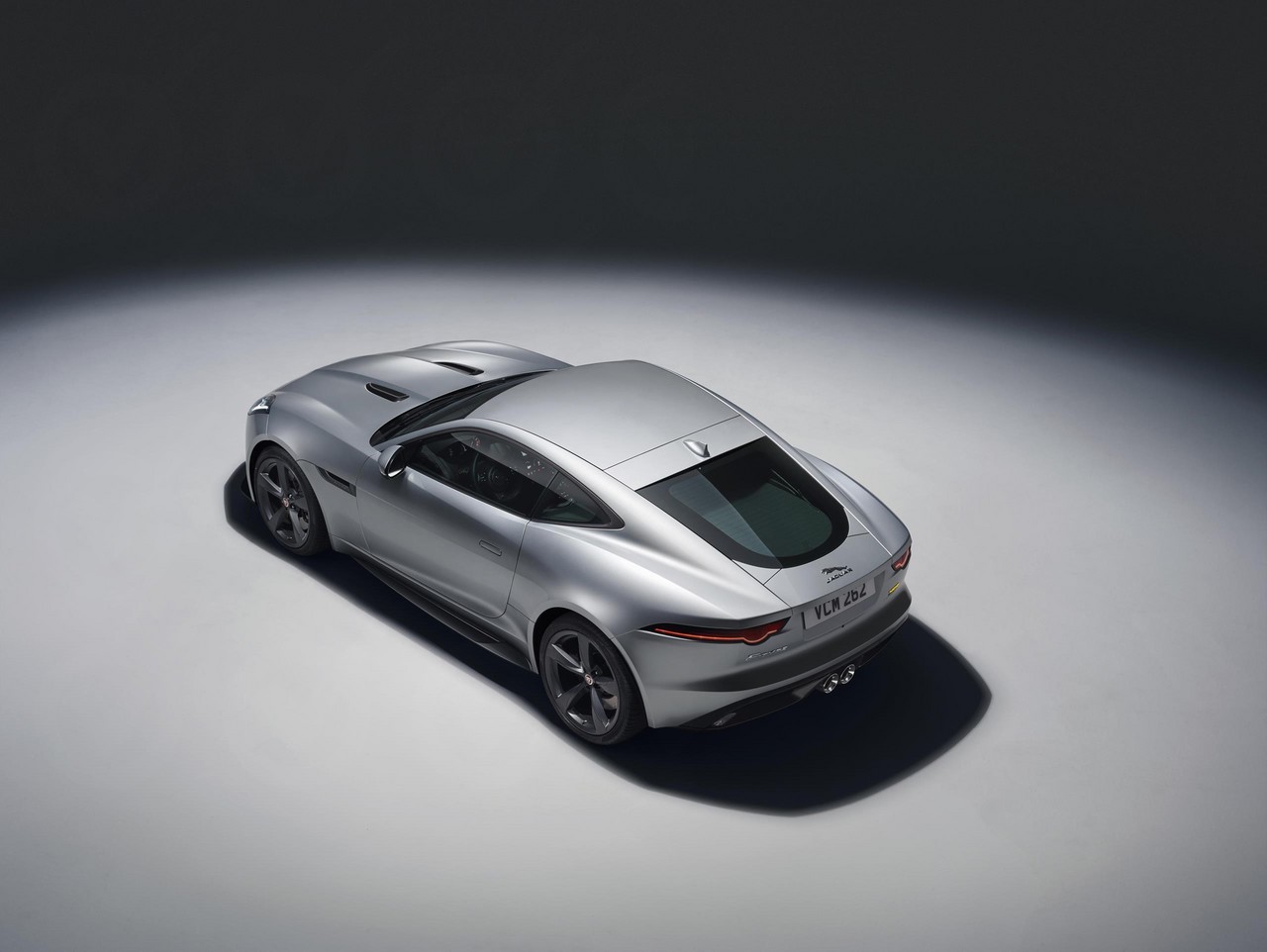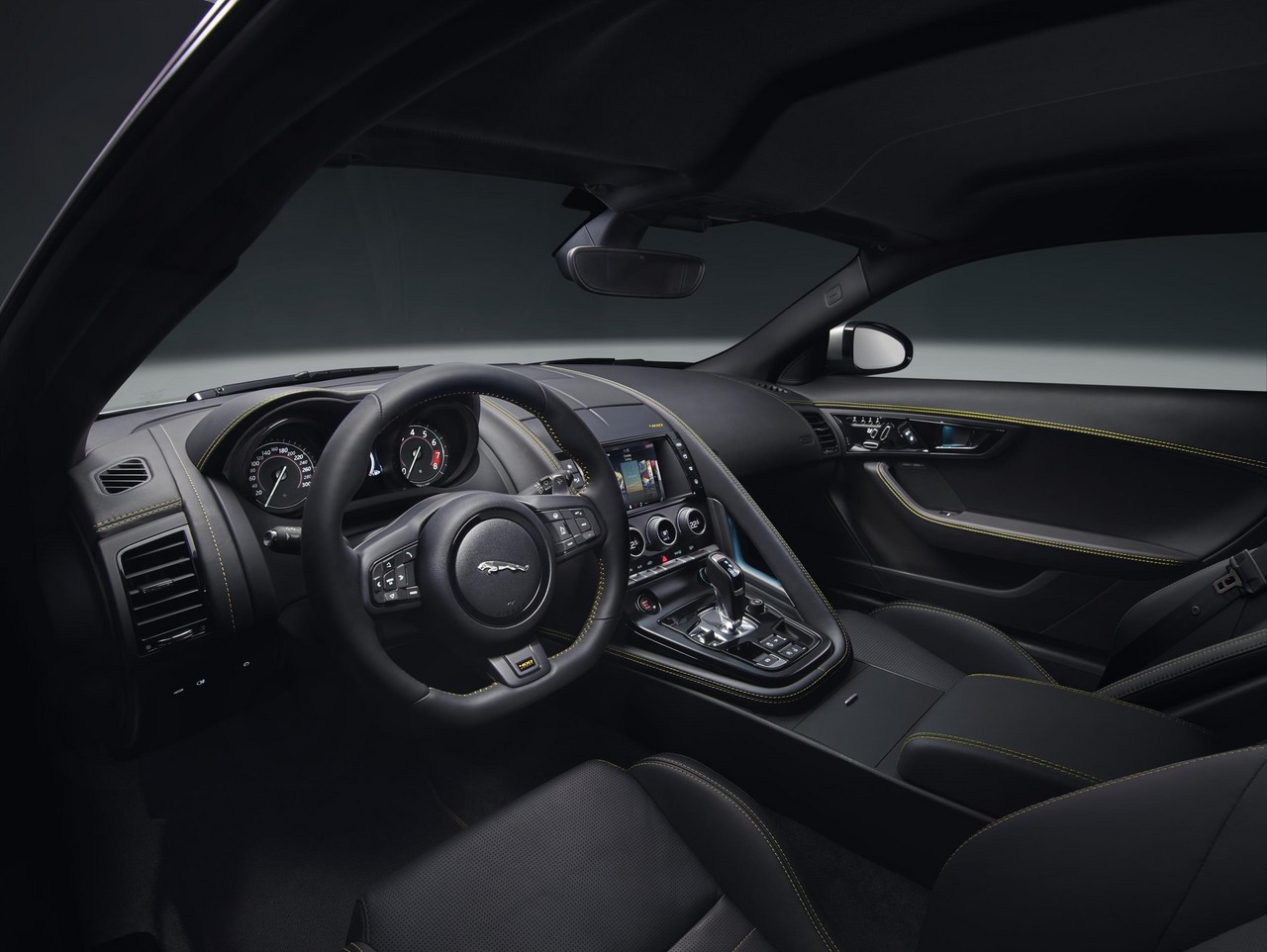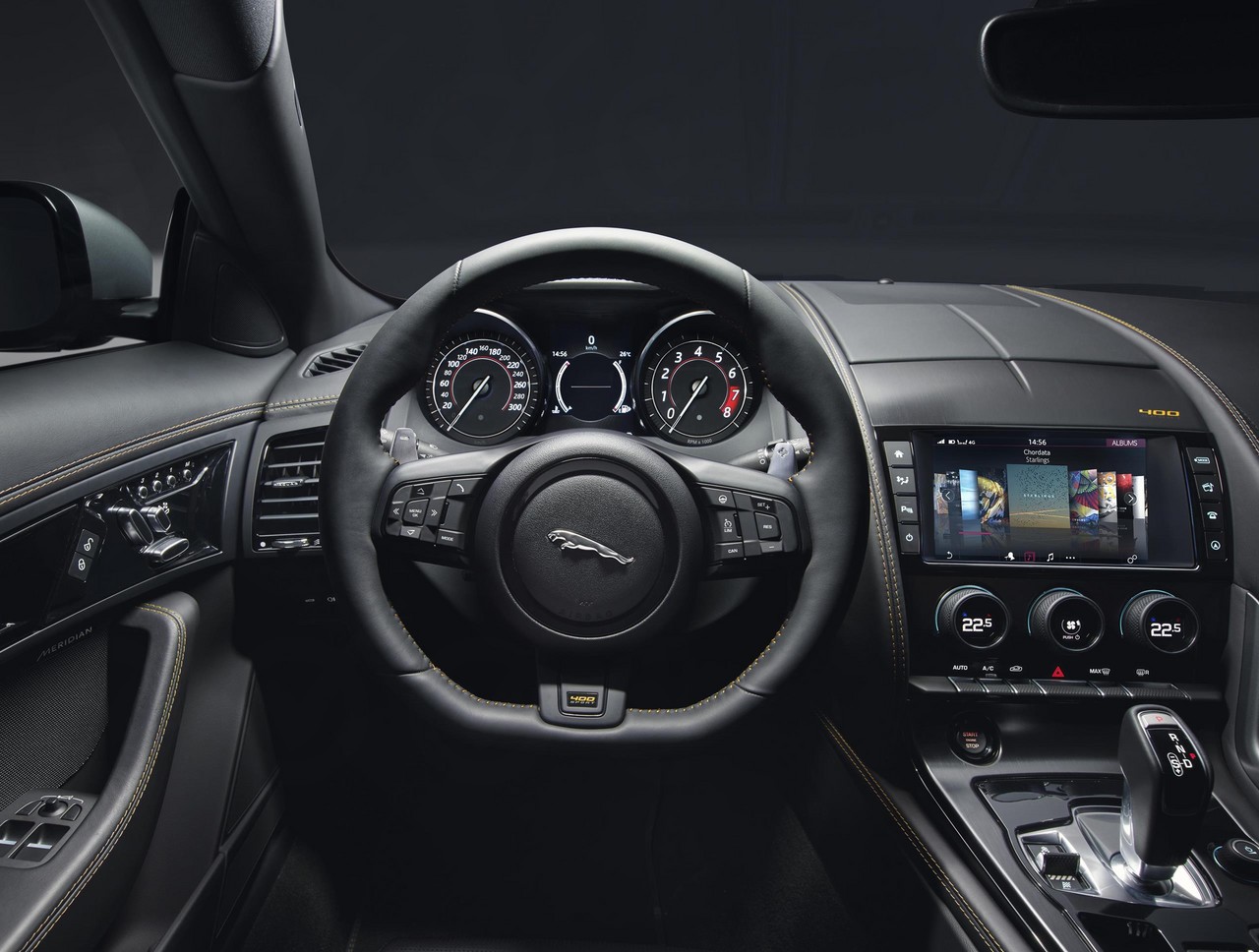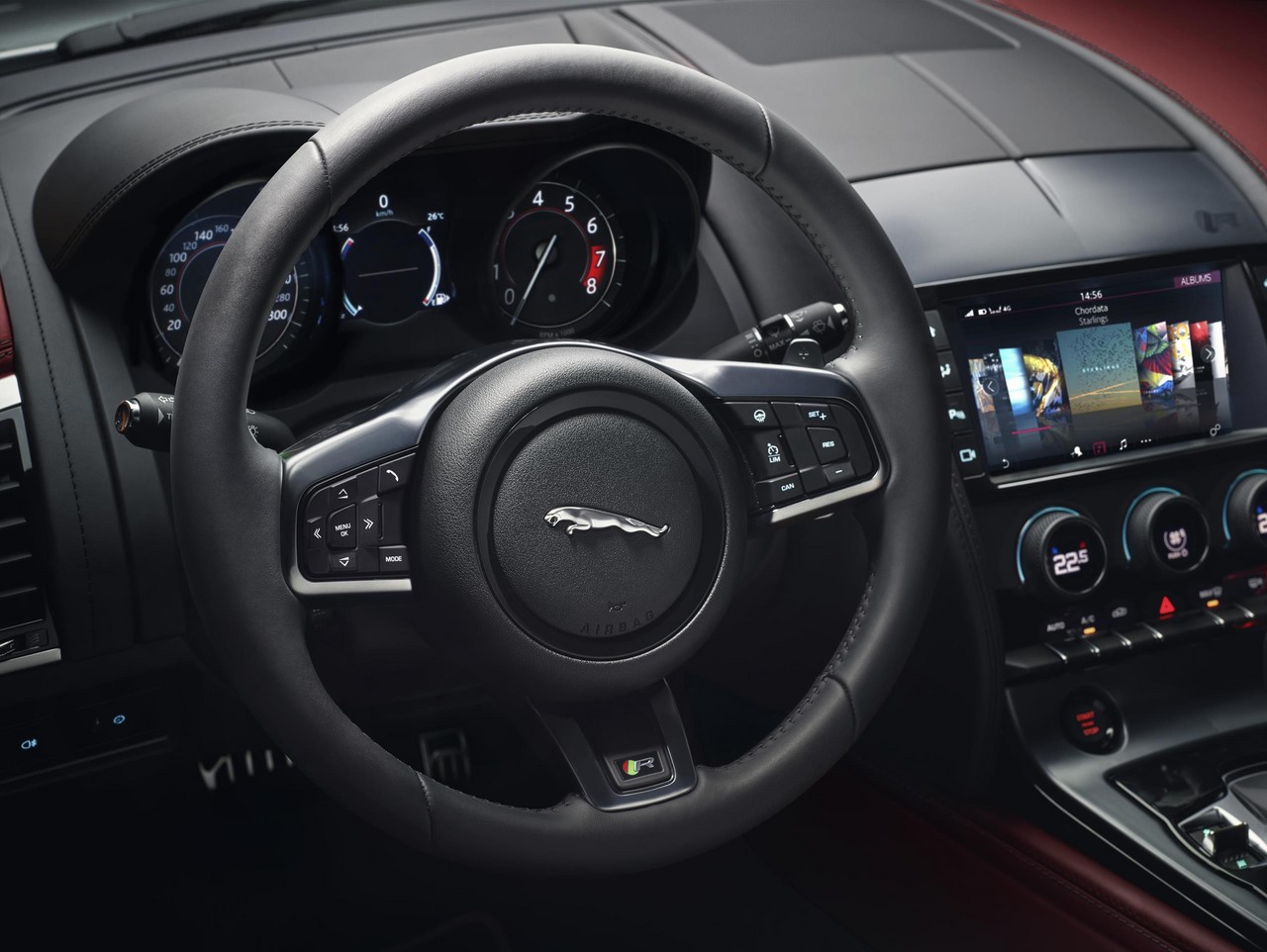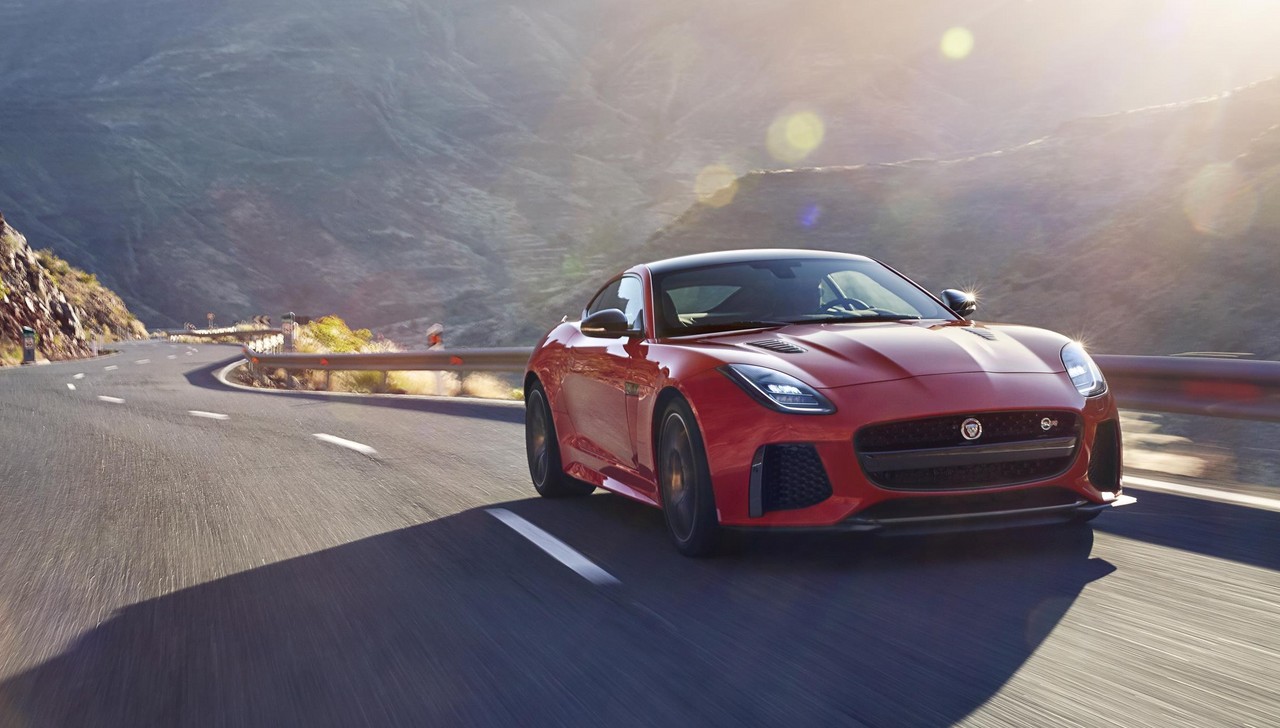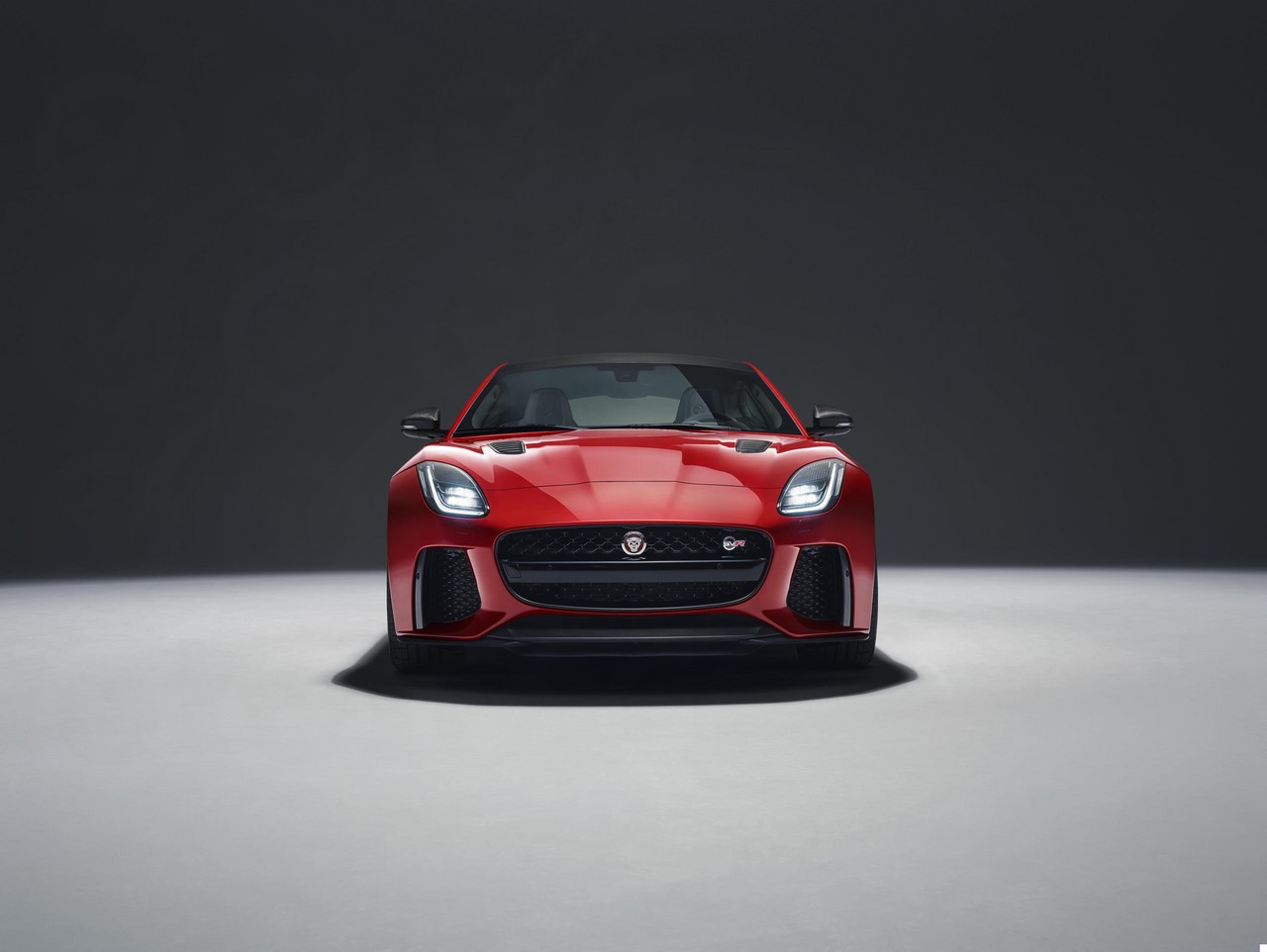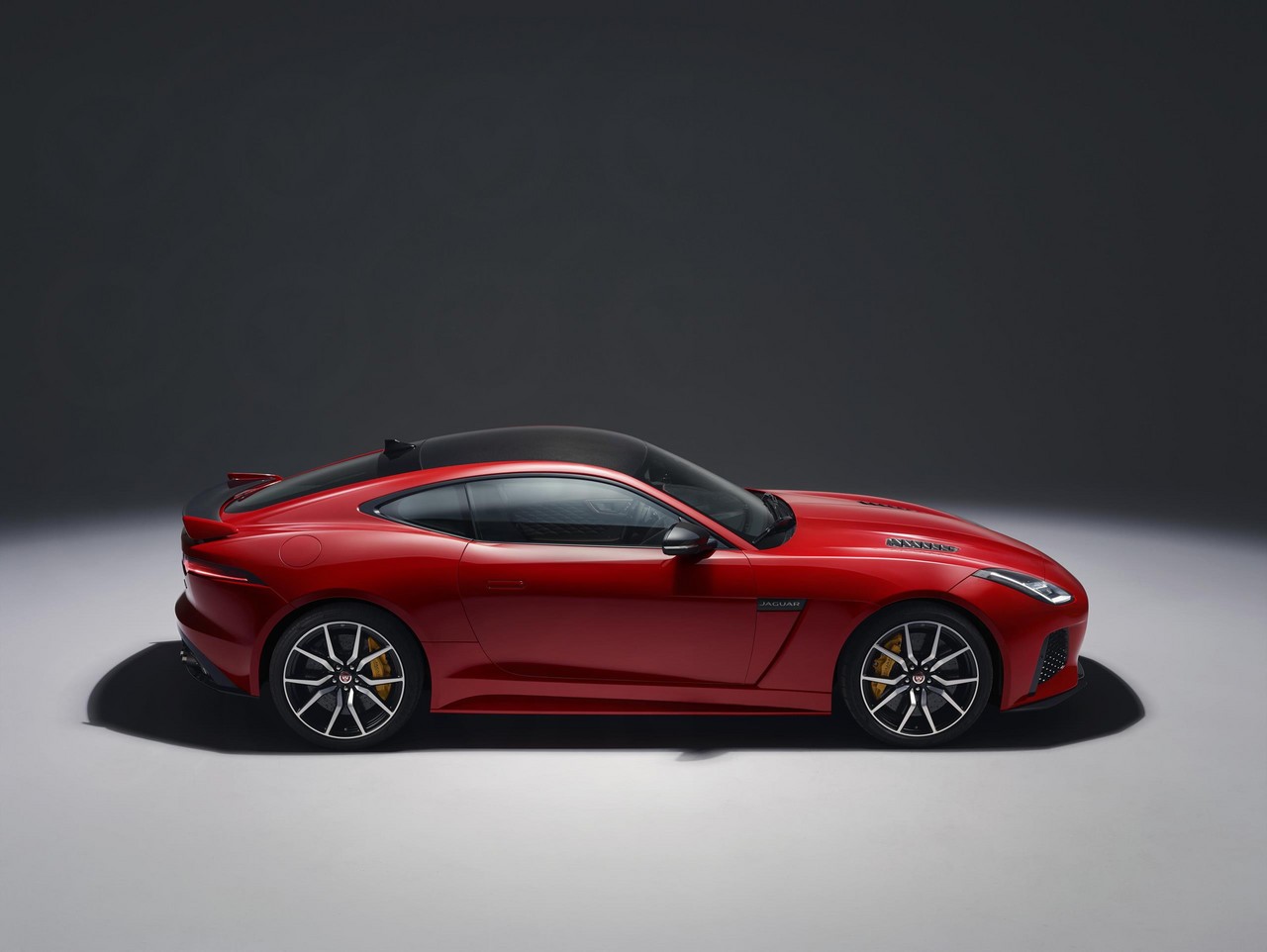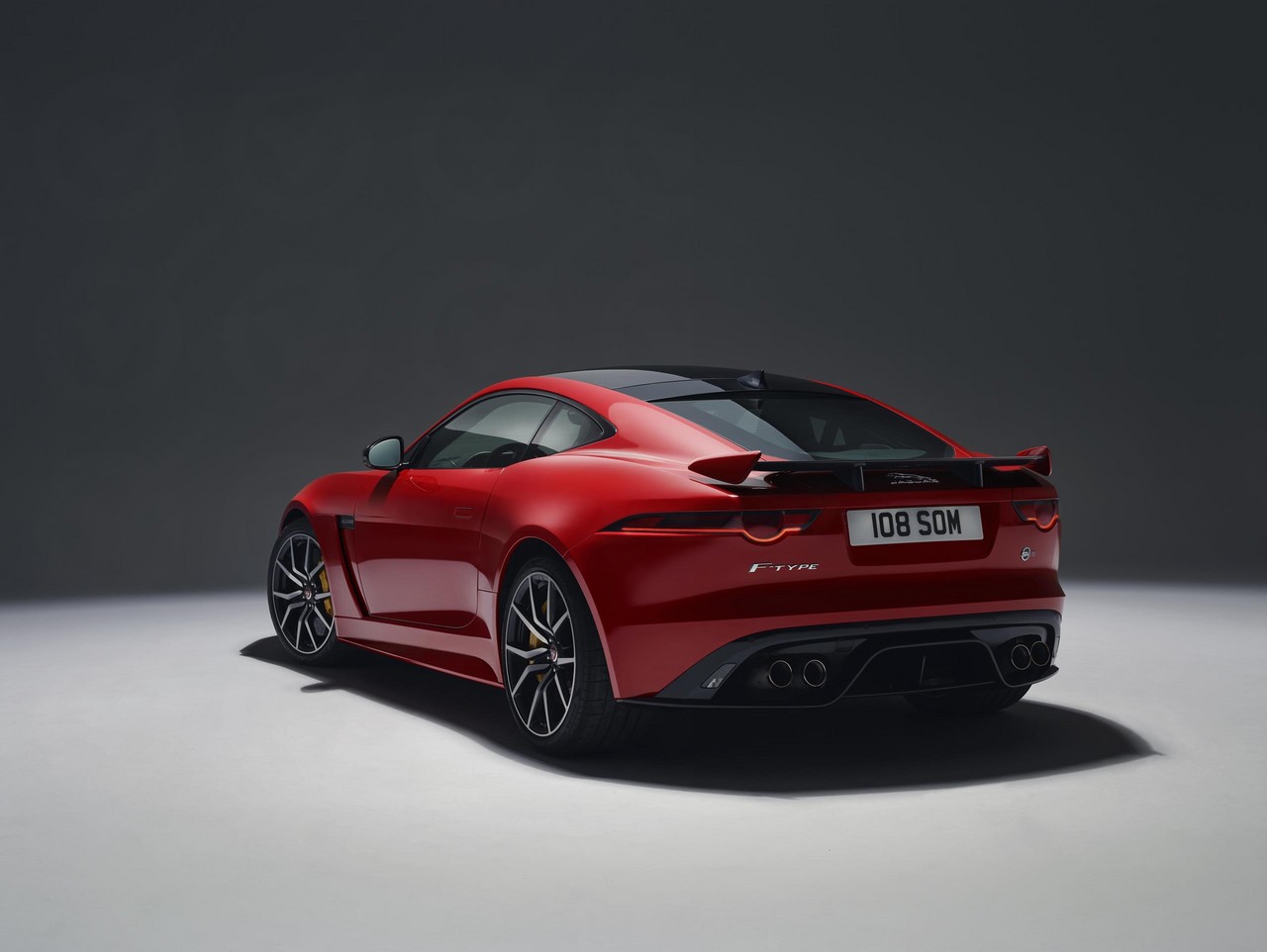
- Strong, sonorous V6 and V8 engines
- Excellent ride/handling balance
- Accurate steering provides good feedback
- Distinctive styling
- Driving experience lacks the purity of the Porsche 981 Cayman
- Disappointing ten speaker Meridian sound system
- Limited boot space
Review: Jaguar X152.I F-Type Coupe (2014-17)
Overview
The Jaguar X152 F-Type Coupe was released in Australia in July 2014 (the X152 F-Type Roadster has been reviewed separately). Manufactured in Birmingham, England, the range initially consisted of rear-wheel drive F-Type, F-Type S and F-Type R variants. For the ‘2016 model year’ F-Type, which will be available in Australia from July 2015, all-wheel drive models will also be available.
Supercharged V6 and V8 engines
The 3.0- and 5.0-litre supercharged petrol engines had lightweight die-cast aluminium blocks, cross-bolted main bearing caps, direct fuel injection, dual independent variable cam timing (DIVCT), a Roots-type twin vortex supercharger (mounted in the engine’s ‘V’) and two water-cooled intercoolers. Furthermore, all engines had an ‘Intelligent Stop/Start’ function which could shut down the engine when the vehicle was stationary to minimise fuel consumption.
| Engine | Trans. | Drive | Years | Peak power | Peak torque | |
|---|---|---|---|---|---|---|
| F-Type V6 | 3.0-litre supercharged petrol V6 | 8sp auto | RWD | 2014-17 | 250 kW at 6500 rpm | 450 Nm at 3500-5500 rpm |
| 6sp man. | RWD | 2015-17 | ||||
| F-Type V6 S | 3.0-litre supercharged petrol V6 | 8sp auto | RWD | 2014-17 | 280 kW at 6500 rpm | 460 Nm at 3500-5500 rpm |
| AWD | 2015-17 | |||||
| 6sp man. | RWD | 2015-17 | ||||
| F-Type R | 5.0-litre supercharged petrol V8 | 8sp auto | RWD | 2014-17 | 404 kW at 6500 rpm | 680 Nm at 2500-5500 rpm |
| AWD | 2015-17 |
Quickshift automatic transmission
The eight-speed ‘Quickshift’ automatic transmission – fitted as standard – had sequential shift function which could be engaged via the steering wheel gearshift paddles or the console-mounted selector. Once the transmission had shifted into second gear, a locking clutch bypassed the torque converter, creating a direct mechanical link between the engine and the rear wheels. The transmission also had a downshift rev matching function whereby the transmission would instruct the engine management system to automatically blip the throttle to match engine revs for multiple, rapid downshifts under hard braking. Other features included:
- An adaptive shift strategy with 25 different programs;
- A ‘Corner Recognition’ function that enabled the transmission to hold its ratio to ensure the correct gear when exiting a corner;
- Software that could recognise a series of overtaking manoeuvres which required rapid changes in throttle position and, rather than upshift, the transmission would hold a lower gear in anticipation of the next acceleration; and,
- A ‘Dynamic Launch Mode’ for track-driving.
Manual transmission
From July 2015, the Jaguar F-Type and F-Type S models were available with a six-speed manual transmission. The close-ratio manual transmission was operated via a short-travel gear lever – with a throw of only 45 mm – and a clutch pedal positioned for heel-and-toe gear changes. For models with the manual transmission, the ECU provided a speed matching function on upshifts for smoother gear changes.
AWD system
From April 2015 (‘MY16’), the Jaguar F-Type was available with an on-demand all-wheel drive (AWD) system which utilised Jaguar’s ‘Intelligent Driveline Dynamics’ (IDD) system to control the centre coupling and rear differential. In normal conditions, 100 per cent of the engine’s torque was directed to the rear wheels. However, if the system detected that the rear wheels were approaching the limit of available grip, an electromechanically-actuated coupling in the transfer case would engage to transfer torque to the front axle. The IDD system also enabled the front:rear torque split to be varied to mitigate oversteer during fast cornering by providing yaw damping.
For the AWD models, the suspension had recalibrated control software for the electronically-controlled dampers; other changes included stiffer springs (by up to 10 per cent) and stiffer front control arm bushes.
Visually, the AWD models could be identified by their bonnets which had a deeper ‘power bulge’ and distinctive vents; the all-wheel drive F-Type V6 S also had 19-inch ‘Volution’ alloy wheels in either silver or diamond-turned Technical Grey.
Body and dimensions
The Jaguar F-Type Coupe had a riveted and bonded aluminium structure which had torsional rigidity of 33,000 Nm/degree. To achieve this, the body side panel was made from a single piece of high-strength and formable AC600 aluminium and a high-strength, hydro-formed aluminium alloy beam extended from the front of the A-pillar to the back of the D-pillar.
The F-Type Coupe was initially available with either aluminium or panoramic glass roof panels that were bonded into the main structure such that torsional rigidity was the same. The MY16 F-Type will also be available with a carbon-fibre roof which weighs 4.25 kg.
Compared to the Jaguar X150 XK , the X152 F-Type Coupe was 320 mm shorter (at 4470 mm), 31 mm wider (1923 mm), 19 mm lower (1309 mm) and had a 128 mm shorter wheelbase (2622 mm).
Suspension
The Jaguar F-Type Coupe had all-aluminium double wishbone front and rear suspension. For the F-Type S and F-Type R, the suspension included Jaguar’s ‘Adaptive Dynamics’ damping system which continuously monitored driver inputs and the attitude of the vehicle, adjusting damper rates up to 500 times a second to control vertical body movement, roll and pitch.
Steering
Initially, the Jaguar F-Type had hydraulic power-assisted steering. In April 2015 (the MY16 F-Type), electric power-assisted steering was introduced as standard across the range. For the electric steering system, the torsional stiffness of the steering column intermediate shaft was increased to improve on-centre feel.
Safety equipment
Standard safety equipment for the Jaguar F-Type Coupe included dual front airbags, front seat-mounted side airbags (with head protection), ABS, electronic brake force distribution, brake assist, electronic stability control, traction control and front seatbelts with pretensioners and load limiters.
Braking packages
The Jaguar ‘Performance Braking’ package for the F-Type consisted of 354 mm front brake discs and 325 mm rear discs (with silver calipers). The F-Type S and F-Type R were fitted with 380 mm front brake discs, while the latter was also fitted with 376 mm rear discs.
As an extra-cost option, the F-Type S and R were available with a Carbon Ceramic Matrix (CCM) braking system which consists of 398 mm front and 380 mm rear discs. Compared to the conventional steel discs, the CCM system reduced unsprung weight by 21 kg.
Features: F-Type V6 and V6 S
Standard features for the F-Type Coupe V6 included 18-inch ‘Vela’ alloy wheels with 245/45 R18 front and 275/40 R18 rear tyres, a 380 watt Meridian sound system with ten speakers, a CD/DVD player, MP3/WMA compatibility, auxiliary inputs (3.5 mm/USB/iPod) and Bluetooth mobile phone connectivity, satellite navigation with an eight-inch touch screen, sports seats with leather and suede cloth facings, climate control air conditioning, cruise control with speed limiter, bi-xenon HID headlights with washers and LEDs, automatic headlights, rear parking sensors, a three-spoke leather-wrapped steering wheel, black gearshift paddles, remote central locking and keyless entry, push-button start, power windows, power adjustable and heated mirrors, a height and reach adjustable steering wheel, an electrochromatic rear view mirror, ambient lighting, a 12 volt power outlet, trip computer, an alarm and immobiliser.
The F-Type V6 S was further equipped with 19-inch ‘Propeller Silver’ alloy wheels with 245/40 R19 front and 275/35 R19 rear tyres, ‘Ignis’ gearshift paddles and a mechanical limited slip differential.
Initially, the V6 S and F-Type R were fitted with an Active Exhaust system which used electronically-controlled bypass valves to enhance the exhaust note during hard accelerations. From mid-2015, however, the Active Exhaust system was standard across the F-Type range.
Features: F-Type R
Compared to the V6 S, the F-Type R was distinguished by its silver-finish 20-inch ‘Gyrodyne’ alloy wheels with 255/35 R20 front and 295/30 R20 rear tyres, ‘Performance’ seats with inflatable side-bolsters and prominent wings, premium leather upholstery (including the instrument panel and binnacle, armrests, door inserts and centre console) and a switchable exhaust system.
Electronic Active Differential and Torque Vectoring
The F-Type R was fitted with an Electronic Active Differential (EAD). Working in conjunction with the ABS, electronic stability control and traction control systems, the EAD could direct torque to the rear wheel with the most grip for greater acceleration (i.e. torque vectoring).
From April 2015, torque vectoring was available as an option for the F-Type V6 and V6 S.
Brochure
Related links
Review: Jaguar X152.II F-Type Coupe (2017-24)
Overview
Production of the Jaguar X152 Series II (X152.II) F-Type Coupe commenced in July 2017. Visually, the Jaguar X152.II F-Type could be identified by its new full-LED headlights, front bumpers and LED tail-light clusters.
Inside, the X152.II F-Type featured more supportive slimline front seats, new finishers for the centre console (depending on variant), a ‘Satin Chrome’ finish for the engine-start button and gearshift paddles, and a ‘Noble Chrome’ finish for the door switch packs, air vent bezels and steering wheel. The seat frames were also produced from pressure die-cast magnesium alloy for a mass reduction of 8 kg relative to their predecessors. For the F-Type 400 Sport, R and SVR, the ‘Performance’ seats had greater detailing and more pronounced wings at shoulder height.
Jaguar F-Type: four-cylinder Ingenium engine
From the fourth quarter of 2017, the Jaguar X152 F-Type was available with a 2.0-litre, four-cylinder petrol engine. The 1997 cc ‘Ingenium’ engine had an aluminium alloy block with 83.0 mm bores and a 92.4 mm stroke; to reduce tangential forces on the cylinder walls, the bores were offset by 12 mm. The aluminium alloy cylinder head had an integrated exhaust manifold which enabled coolant to flow through ducts in the manifold to reduce warm-up times and maximum exhaust gas temperatures. The Ingenium engine utilised a twin-scroll turbocharger – which minimised exhaust gas pulsation interference to generate boost pressure faster – and a water-cooled charge air cooler (or intercooler). Other features of the Ingenium engine included needle roller bearings for the twin balancer shafts and camshafts, a map-controlled oil pump, switchable piston cooling jets and a split cooling system with a map-controlled electric coolant pump (so that coolant only circulated through the cylinder block once it had reached operating temperature).
In addition to intake and exhaust cam phasers, the Ingenium engine had an electrohydraulic valvetrain which provided variable control of intake valve lift. With this system, load control was managed primarily by varying intake valve lift and duration (rather than a throttle valve and retarding ignition timing). As such, the engine had four operating modes –
- Start-up: late intake valve opening, low valve lift and short duration;
- ‘Composite’ (for low speeds and loads): early intake valve closing and late intake valve opening to enhance charge motion for more complete combustion;
- Part-loads (such as low-speed driving or highway cruising): early intake valve closing and later exhaust valve opening, effectively increasing the expansion ratio for greater efficiency; and,
- Full loads: full valve lift, long duration and earlier exhaust valve opening to maximise air flow through the cylinders.
With the electrohydraulic valvetrain, the intake camshafts did not actuate the valves directly, but actuated compact hydraulic pumps via low-friction roller finger followers – the oil pressure generated in these pumps was then used to open and close the intake valves. Each pump was actuated by a solenoid valve that was controlled by software. When the solenoids were fully open, there is no valve lift; when closed, full lift of 11 mm was achieved.
The Ingenium engine had direct petrol injection with a maximum pressure of 200 bar; the compression ratio was 9.5:1. Compared to the F-Type V6, the four-cylinder F-Type was 52 kg lighter (1525 kg and 1545 kg for the coupe and convertible, respectively).
| Variant | Engine | Drive | Trans. | Peak power | Peak torque |
|---|---|---|---|---|---|
| I4 (221 kW) | 2.0-litre turbo petrol I4 | RWD | 8sp auto | 221 kW at 5500 rpm | 400 Nm at 1500-4500 rpm |
| V6 (250 kW) | 3.0-litre super-charged petrol V6 | RWD | 8sp auto | 250 kW at 6500 rpm | 450 Nm at 3500-5500 rpm |
| AWD | 6sp man. | ||||
| V6 R-Dynamic (250 kW) | 3.0-litre super-charged petrol V6 | RWD | 6sp man., 8sp auto |
250 kW at 6500 rpm | 450 Nm at 3500-5500 rpm |
| V6 (280 kW) | 3.0-litre super-charged petrol V6 | RWD | 6sp man., 8sp auto |
280 kW at 6500 rpm | 460 Nm at 3500-5500 rpm |
| AWD | 8sp auto | ||||
| V6 R-Dynamic (280 kW) | 3.0-litre super-charged petrol V6 | RWD | 6sp man., 8sp auto |
280 kW at 6500 rpm | 460 Nm at 3500-5500 rpm |
| AWD | 8sp auto | ||||
| V6 400 Sport | 3.0-litre super-charged petrol V6 | RWD, AWD |
8sp auto | 294 kW at 6500 rpm | 460 Nm at 3500-5500 rpm |
| V8 R | 5.0-litre super-charged petrol V8 | RWD | 8sp auto | 405 kW at 6500 rpm | 680 Nm at 3500 rpm |
| V8 SVR | 5.0-litre super-charged petrol V8 | AWD | 8sp auto | 423 kW at 6500 rpm | 700 Nm at 3500-5000 rpm |
Safety equipment
As standard, the Jaguar X152.II F-Type Coupe was fitted with a forward-facing stereo camera which provided the following active safety technologies –
- Autonomous Emergency Braking (AEB): if a collision with the vehicle ahead was assessed to be imminent, full braking was initiated automatically to prevent the collision or reduce its severity; and,
- Lane Departure Warning (LDW): by monitoring the vehicle’s position relative to lane markings, LDW could alert the driver if the vehicle was about to depart from its lane via a visual warning in the instrument cluster and steering wheel vibrations.
For Australian-delivered vehicles, Lane Keep Assist (LKA) was available as an extra-cost option ($280 at launch). LKA could return the vehicle to the centre of its lane by applying a small amount of counter-steering through the steering system; this steering torque, however, could be over-ridden by the driver.
Features
The Jaguar X152.II F-Type featured Jaguar’s ‘Touch Pro’ infotainment system which featured a 60 GB Solid-State Drive (SSD), an eight-inch touch screen and an Ethernet network to provide navigation functions and online services such as real-time traffic updates and live weather reports. Furthermore, 10 GB was allocated to audio storage.
Within the Jaguar X152.II F-Type range, the R-Dynamic was a new variant which could be identified by its 19- or 20-inch alloy wheels, ‘Gloss Black’ bezels for the front bumper apertures and ‘Gloss Black’ finishes for the front splitter, bonnet vents, side sills and rear diffuser.
Standard features for the Jaguar X152.II F-Type Dynamic, 400 Sport, R and SVR variants included LED headlights with Adaptive Front Lighting and four selectable driving modes: City, Country, Motorway and Bad Weather.
As an extra-cost option, the X152.II F-Type was available with a semi-automated park-assist function which provided automated steering for parallel parking manoeuvres. The system was activated by the driver pressing a button and engaging reverse; while the park-assist function controlled the steering wheel, the driver controlled vehicle speed.
For a complete list of features, see Specifications: Jaguar X152 F-Type (July 2017) .
Jaguar F-Type 400 Sport
The Jaguar F-Type 400 Sport was a limited launch edition that was offered for only one ‘model year’. The F-Type 400 Sport was distinguished by its 20-inch alloy wheels with Dark Satin Grey finish, ‘Super Performance’ brakes (380 mm front and 376 mm rear discs), mechanical limited-slip differential and Jaguar’s ‘Configurable Dynamics’ system for adjustable throttle, transmission, steering and damper settings.
Visually, the Jaguar F-Type 400 Sport could be identified by its front splitter, and Yellow and Dark Satin Grey ‘400 SPORT’ badges at the rear. The F-Type 400 Sport was available in Indus Silver, Santorini Black or Yulong White paint finishes. Inside, the F-Type 400 sport had ‘Performance’ seats with twelve-way adjustment, contrasting yellow stitching and ‘400 SPORT’ branding for the black brushed aluminium centre console finisher, a flat-bottomed steering wheel, treadplates and embroidered headrests.
Specifications
- Specifications: Jaguar X152 F-Type (July 2017) . Note: this document is incorrect in that it omits Autonomous Emergency Braking and Lane Departure Warning from the list of standard safety equipment, though Jaguar Land Rover Australia advises that all other details are correct.
